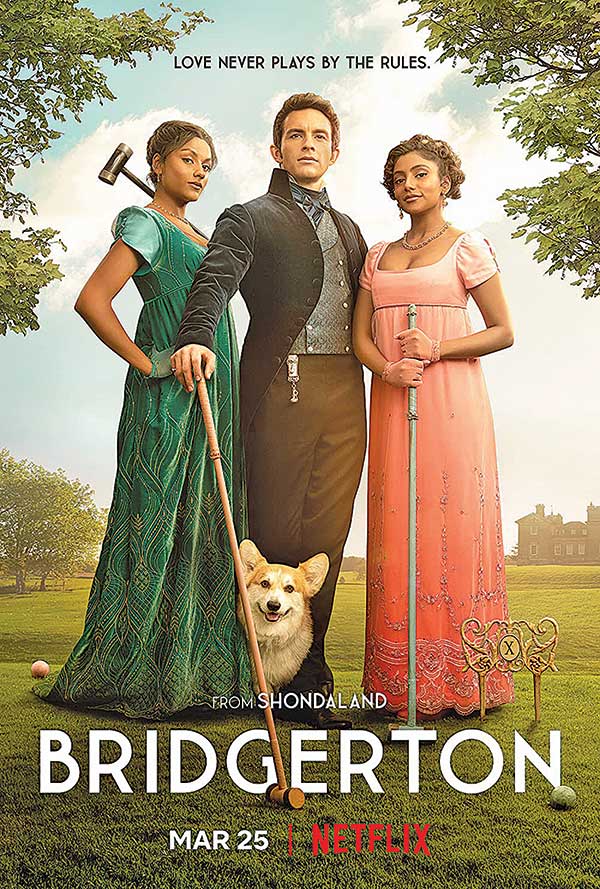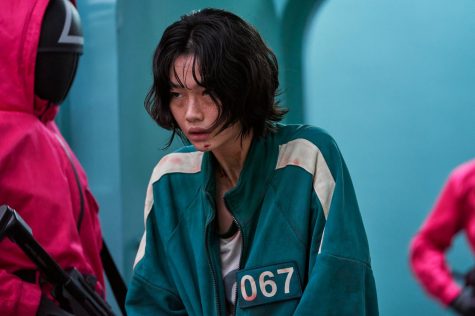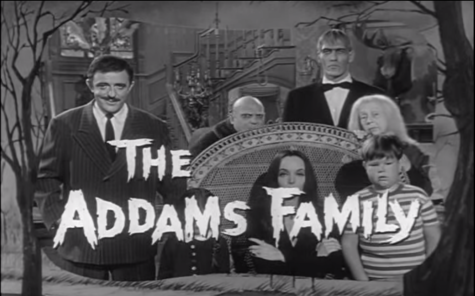Ready for new Bridgerton?
It’s 1813, the height of the Regency era. London, is starting another of its social seasons. Lavish balls are thrown by wealthy families, and the daughters of this class-driven society know their goal in life is to secure a husband. Horse-drawn carriages clatter down the wide, cobbled street. Ladies in sparkling dresses accompanied by men in waistcoats promenade through the park, perhaps holding a parasol to keep off the sun. There is a notable abundance of racial diversity, the only thing that seems to stray from the historical accuracy of the scene. The Bridgerton household, headed by Viscount Anthony Bridgerton, prepares for the season to begin, even as the infamous gossip columnist Lady Whistledown sharpens her pen to begin her commentary on society scandals.
Bridgerton, a Netflix show that came out in December of 2020, was a pandemic binge-watch for many. With the highly anticipated season two just out, the show currently holds the top spot of most played on Netflix.
In season one, Duke of Hastings (Rege-Jean Page ) and Daphne Bridgerton (Phoebe Dynevor) play out a fake romance. In season two, an enemies to lovers storyline stars a new couple. Jonathan Bailey as Anthony Bridgerton returns as the leading actor. His love interest is a new character, Kathani (Kate) Sharma, who is played by Simone Ashley. All of the leads were relatively unknown before the series came out, which allowed for a multitude of new faces and new talent.
The show is based on the best-selling novel series, The Bridgertons, by Julie Quinn. Narrated by Julie Andrews as Lady Whistledown, the show is a nineteenth century Gossip Girl. The plotline of the first season was pretty predictable, but the additional dynamics of family relationships add more moving parts to the storyline. In particular, the tension between the men of the household versus the family matriarch was interesting to see in both the Bridgerton family and another main family, the Featheringtons. Flashbacks, particularly in the second season, provide good insight as to how and why these dynamics developed. The plot of the second season honed in more on the sibling connections, especially among the Sharmas, though parents still played an important role.
These sibling relationships were the star of the show. In particular, Benedict Bridgerton, played by Luke Thompson, has many scenes with his siblings that feel realistic and demonstrate generally healthy and positive familial relationships. In the first season, when one of his sisters, Elouise (Claudia Jessie), is struggling with her role in society and the pressure of being a debutante, he is able listen and relate to her in a way her other siblings don’t seem to be capable of. She, in turn, is able to point out to him that he must actually chase his dreams if he wishes for them to come true. The best part about their scenes together is that, even as they compliment each other, they also mock each other lightly, just as siblings do. In season two, Benedict’s relationship with Elouise continues to grow and provide comedy for the show as both of them attempt to follow their passions while stuck in the roles society has laid out for them.
In addition, Benedict’s relationship with the eldest Bridgerton sibling, Anthony, is shown more. Benedict’s dry humor and light-hearted mocking provide a good contrast to his extremely serious older brother. Anthony’s relationship with Daphne is also interesting, especially because it develops as the show continues. In the beginning of the first season, Anthony feels more removed and controlling, while Daphne is young and naive. Just a few episodes in, though, Anthony is able to recognize that his behaviors have infringed upon her choices and they begin to bond. By the second season, Daphne has grown to giving her older brother advice and even chastising him.
The relationship between Kate and her younger sister, Edwina (Charithra Chandran) is not as well done. While it’s obvious the two share affection, Kate feels more like a mother than a sister. This dynamic is important to the show and was likely intentional. It also made the age gap seem much larger than it actually is. While it’s never explicitly mentioned, this gap is likely only about five years. Based on their interactions, though, it feels much larger than that. This gets a bit weird for me as the love triangle between Kate, Anthony, and Edwina develops, since Edwina feels like a child while the other two are seen as adults.
This problem could’ve been solved if the Sharma mother played a larger role. While she is constantly present, she lives up to the saying ‘seen and not heard’. In addition, this makes it feel extremely incongruous when she does speak, which is not often. In particular, she has a short but angry monologue in the fifth episode. It’s easy to see what triggered her, but it also just feels out of character since she barely has any lines prior. She’s never at the forefront of scenes, so viewers are left unaware of her thoughts and feelings. Though both the Bridgerton and Featherington matriarchs are far from perfect, their characters are a lot more developed and have much more to say.
Unlike the book series, director Shonda Rhimes manages to integrate racial diversity into the show. In another of Rhimes’ big hits, Grey’s Anatomy, the casting was colorblind, and the actors’ and actress’ races were not even considered. However, in this series, she and writer Chris Van Dusen decide to go a different route. They used the debate over whether the real-life Queen Charlotte was of African descent to inspire their casting decisions. Characters mention in several scenes the fact that the queen’s rise in society opened up opportunities for people of color in London in the first season. Season two highlighted diversity in the casting even more. The Sharma sisters were raised in India, and the season features many nods to South Asian traditions; the sisters often use Hindi terms of endearment when speaking to each other. In addition, Kate denounces English tea and is seen making chai. Traditional marital practices are also present before the wedding ceremony in the sixth episode of season two.
While the show is popular, some think the sex scenes overwhelm the plotline in the first season. While there is undeniably a lot of intimacy, it’s important to note that, unlike many period pieces, everything featured is consensual. Especially between the main characters, the communication is very open and honest as their relationships develop. In Daphne’s story, her sexual awakening is a very important part of the plot, and her lack of experience in the topic ends up being a problem for her relationship.
Season two featured a lot less nudity, though there are still a few sex scenes. More important in the second season, though, is the tension that the writers created between the leading characters. All the hand grazing and almost-kissing is intended to put the watcher on edge, waiting for the explosion.
The musical score was composed by Kris Bowers, winner of an Emmy for the animated short film “The Snowy Day.” He’s also an award-winning pianist and has performed with celebrity musicians such as Jay-Z and Kanye West. His original compositions are mixed with well known pop tunes translated into a string quartet, including Taylor Swift’s “Wildest Dreams,” and Maroon 5’s “Girl Like You.” In addition, the show was created and produced during the pandemic, so the songs were performed by only eight musicians who recorded the soundtrack from their homes. The score has been nominated for the 2022 Grammys.
This music especially comes to light during the slow motion scenes, which often appear during balls and other social gatherings. While slow motion can feel overused and excessive, in this show, it allowed the characters to convey emotion and thought processes where words would’ve felt too blunt. In several scenes where the main characters are dancing, the reactions of others in the crowd are important to the storyline, and therefore it’s necessary to allow the audience time to see and understand what they’re doing.
Overall, while the show is not deep or thought-provoking, it provides easy and fun entertainment; the historic setting and fictional characters mix well together. It’s warming to watch the characters ask for explicit consent, the diversity of the cast is refreshing, and the melding of traditional cultural practices with London society is obvious but not overdone. Netflix seems sure that this series will continue to spark interest in viewers, and has already confirmed at least two more seasons.











